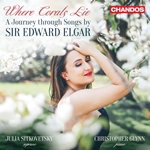SIR EDWARD ELGAR (1857 – 1934)
Where Corals Lie: A Journey through Songs
Sea Pictures, Op.37 (1897-99)
20:02
Version for Soprano and Piano
1.
I
Sea Slumber Song. Andantino - Tranquillo - Tempo I - Molto tranquillo
4:37
2.
II
In Haven (Capri). Allegretto
1:44
3.
III
Sabbath Morning at Sea. Moderato - Più mosso - Tempo I -
5:01
4.
IV
Where Corals Lie. Allegretto, ma non troppo
3:31
5.
V
The Swimmer. Allegro di molto - Largamente - Poco meno mosso - Tempo I - Largamente
5:10
From 'Sieben Lieder' (1887-94)
13:30
6.
7
The Shepherd's Song (1892), Op.16 No.1. Allegretto
2:43
7.
1
Like to the damask rose (1891). Allegro
3:07
8.
2
Queen Mary's Song ('The Lute Song') (1887, rev. 1889). Moderato - Più lento
3:24
9.
3
A Song of Autumn (c.1892). Poco allegretto
2:42
10.
6
Rondel (1894), Op.16 No.3. Allegretto scherzando
1:32
Two Songs, Op.60 (1909-10)
4:58
Folk-Songs (Eastern Europe, 'Leyrisch-Turasp')
Paraphrased by 'Pietro d'Alba' and Edward Elgar
11.
I
The Torch. To Yvonne. Allegro con fucco - Poco meno mosso -
1:42
12.
2
The River. Allegro con fuoco
3:16
13.
Pleading, Op.48 (1908)
2:29
To Lady Maud Warrender
Andante - Lento - Andante - Lento molto espressivo
14.
The Muleteer's Serenade (1894)
2:26
From Don Quixote
Andante mesto
15.
The Self Banished (c.1875)
3:56
Moderato espressivo - Allegro - Meno mosso - Tranquillo -
Poco più lento - Lento
16.
Speak, Music!, Op.41 No.2 (1902)
2:49
from Two Songs
to Mrs Edward Speyer, Ridgehurst
Allegretto comodo
17.
After, Op.31 No.1 (1895)
2:42
Moderato - Più mosso - Più lento - Lento - Tempo I - Lento
18.
In Moonlight (1904)
2:04
Words by Shelley adapted to the 'Canto popolare'
from the Concert Overture In the South (Alassio), Op.50 (1903-04)
Molto moderato
premiere recording in version with piano
19.
When the spring comes round (1915)
4:55
('Quand nos bourgeons se rouvriront')
from Une voix dans le désert, Op.77
for Speaker and Orchestra
Arranged by the composer for Voice and Piano
Allegretto - Animé - Più lento - Come prima - Più lento -
premiere recording in this version
Adapted 1900 for Voice and Piano by Max Laistner (1853-1917)
from Salut d'amour, Op.12 (1888)
for Violin and Piano
To Carice
Andantino - Più mosso - Tempo I
Solo: Julia Sitkovetsky soprano
Solo: Christopher Glynn piano
















 My Wish List
My Wish List




